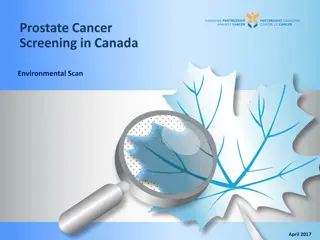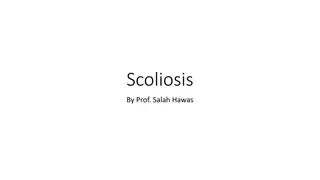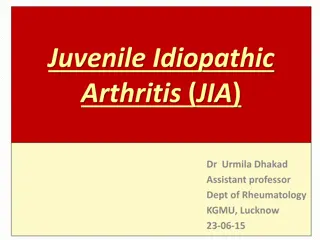Understanding Adolescent Idiopathic Scoliosis: Screening, Signs, and Management
Adolescent Idiopathic Scoliosis is a lateral curvature of the spine, affecting 2-4% of adolescents. Screening for scoliosis is important, with recommendations for annual checks by the AAP. Signs of scoliosis include asymmetry of shoulders, hips, and back creases. If scoliosis is detected, additional screenings for various factors are necessary. Measurement of the degree of curvature is done using a scoliometer and X-rays. Early detection through screening may impact progression, and management decisions are based on the severity of curvature.
Download Presentation

Please find below an Image/Link to download the presentation.
The content on the website is provided AS IS for your information and personal use only. It may not be sold, licensed, or shared on other websites without obtaining consent from the author. Download presentation by click this link. If you encounter any issues during the download, it is possible that the publisher has removed the file from their server.
E N D
Presentation Transcript
Allison Eliscu, MD, FAAP Rev. Aug 2012
What is Adolescent Idiopathic Scoliosis? Lateral curvature in spine >10 with rotational curvature Categorized by: Degree of curvature by Cobb angle Location of curve: thoracic, lumbar, thoracolumbar Direction of curve: right or left based on its convexity Affects 2-4% of adolescents <10% of affected patients will need management Occurrence in males = females Much more likely to progress in females
Screening for Scoliosis Annual screening is controversial Does early detection change the progression? (Possibly) Does untreated scoliosis cause morbidity? (Unlikely) AAP recommends screening: Females at 10 and 12 years old Males at 13-14 years old Annual school screening mandatory in some states Not all patients detected by screening require X-ray
Signs of Scoliosis Asymmetry of shoulders, hips, back creases or scapulae Prominence on Adams Forward Bending Test Standing with feet and knees together Bend forward with palms facing each other Examine from behind, sides, and front Look for asymmetry, rib hump, or spine curve Rib Hump Adams Forward Bending Test Scoliosis Deformity Normal Spine
If Scoliosis is Detected, Also Screen For History Physical Exam Back pain or stiffness Height Skin lesions Unusual in idiopathic scoliosis History of diagnosis & progression Muscle weakness Bowel/bladder problems Difficulty breathing Growth trajectory Age of menarche Family history of scoliosis Sacral dimple or tuft Caf -au-lait macules Neurological deficits Deep tendon reflexes Sensory and motor exam Gait Tanner stage Leg length
Measure the Degree of Curvature Scoliometer X-Ray Similar to carpenter s level Run along patient s spine Ball deviates if rotation present X-ray if 5-7 curvature Gold standard to diagnose scoliosis Standing PA and Lateral images Measure Cobb Angle
Natural History of Scoliosis Typically worsens 1 every month until skeletal maturity Progression of scoliosis defined as 5 on Cobb Angle Increased risk of progression: Gender Females more likely to progress than males Severity of curve Severe curves more likely to progress Maturity Immature and premenarchal patients more likely to progress
Initial Management of Scoliosis Large asymmetry on exam Scoliometer >5-7 Asymmetry in skeletally immature patient Asymmetry in patient with family history of scoliosis Get X-Ray Observe with frequent exams and X-ray in 6-8 months Scoliometer <5-7 Cobb angle 20 Scoliometer >7 and can t obtain Cobb angle Cobb angle >20-30 (especially in skeletally immature) Progression of Cobb angle by 5 Refer to Orthopedist
Treatment Options - Braces Only indicated in skeletally immature patients Goal to prevent progression of curvature Does NOT improve curvature Use if Cobb angle 25-40 Improved results with increased use (~23 hours/day) X-ray every 6-8 months without brace to check progression Continue use 2 years after menarche Thoraco-lumbar-sacral-orthosis Brace (TLSO)
Treatment Options - Surgery Recommended for patients with: Cobb angle >40-45 in skeletally immature Cobb angle>50 in any patient Goals: Prevent progression of curvature (Primary Goal) Correction of curve Improve quality of life Anterior or posterior approach Post-op expectations: 5-7 day hospital stay Return to school in 3-4 weeks Return to contact sports in 6-9 months
On a routine physical examination, you discover that an 11 year old premenarchal female patient has an abnormal prominence on her upper back during the forward bending test. Which of the following statements are you most likely to include in your discussion with the patient and her parents about thoraco- lumbar-sacral-orthosis (TLSO) braces: A. She may need to wear a TLSO brace in order to correct the curvature of her spine B. She may benefit from wearing a TLSO brace since she is skeletally immature C. A TLSO brace is recommended at this point to prevent restrictive lung disease which is extremely common in these patients D. She will only need to wear a brace if her Cobb angle on X-ray is <10
On a routine physical examination, you discover that an 11 year old premenarchal female patient has an abnormal prominence on her upper back during the forward bending test. Which of the following statements are you most likely to include in your discussion with the patient and her parents about thoraco- lumbar-sacral-orthosis (TLSO) braces: A. She may need to wear a TLSO brace in order to correct the curvature of her spine B. She may benefit from wearing a TLSO brace since she is skeletally immature C. A TLSO brace is recommended at this point to prevent restrictive lung disease which is extremely common in these patients D. She will only need to wear a brace if her Cobb angle on X-ray is <10
Answer: B. Braces are only helpful in skeletally immature patients and are used to prevent progression of curvature rather than to correct the curvature. Cobb angle of <10 is not consistent with scoliosis and so does not require a brace. Restrictive lung disease is rare in otherwise healthy adolescents with idiopathic scoliosis
A 12 year old female is referred to you by the school nurse after she detected an abnormality during the routine school-wide scoliosis screen. The most appropriate initial step is to: A. Obtain an X-ray to determine the Cobb angle B. Repeat the forward bending test C. Refer her to an orthopedist D. Fit her for a thoraco-lumbar-sacral-orthosis (TLSO) brace
A 12 year old female is referred to you by the school nurse after she detected an abnormality during the routine school-wide scoliosis screen. The most appropriate initial step is to: A. Obtain an X-ray to determine the Cobb angle B. Repeat the forward bending test C. Refer her to an orthopedist D. Fit her for a thoraco-lumbar-sacral-orthosis (TLSO) brace
Answer: B. You should repeat the forward bending test yourself to insure that scoliosis is present before trying to manage her scoliosis. If she has a large curve on exam or >5-7 curve by scoliometer then she should have an x-ray to determine the Cobb angle. If there is a Cobb angle of >20 , she should be referred to an orthopedist.
Recommended Reading Kim HJ, Blanco JS, Widmann RF. Update on the Management of Idiopathic Scoliosis. Curr Opin Pediatr. 2009;21(1):55-64. Stewart DG and Skaggs DL. Consultation with the Specialist: Adolescent Idiopathic Scoliosis. Pediatr Rev. 2006;27(8):299-306. Richards BS, Vitale MG. Screening for Idiopathic Scoliosis in Adolescents. An Information Statement. J Bone Joint Surg Am 2008;90:195-198. Scherl SA. Clinical Features; Evaluation; and Diagnosis of Adolescent Idiopathic Scholiosis. UpToDate Online. Updated May 21, 2009. Scherl SA. Treatment and Prognosis of Adolescent Idiopathic Scoliosis. UpToDate Online. Updated June 9, 2009. Scoliosis Research Society website. http://www.srs.org/























